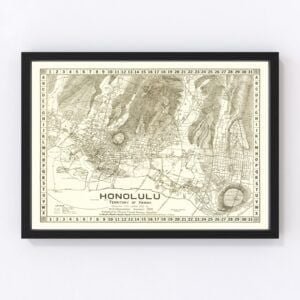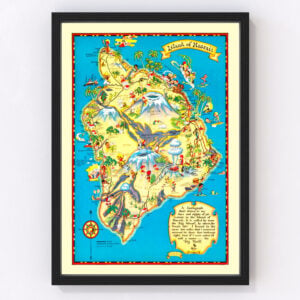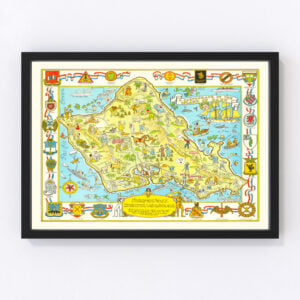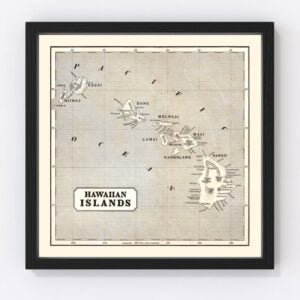Vintage Hawaii Maps
Hawaii, the only state outside North America and the only one in the tropics, was admitted to the union in 1959. It has eight main islands—Niʻihau, Kauaʻi, Oʻahu, Molokaʻi, Lānaʻi, Kahoʻolawe (uninhabited), Maui, and Hawaiʻi, plus 129 small islands. Combined, they make up what's called the Hawaiian archipelago.
In our archives, you'll find vintage maps of Hawaii dating back to 1846, as well as old Honolulu maps from the late 1800s. If you're looking for a specific Hawaii map and don't see it here, contact us, and we'll be happy to check our archives for you. While we have an extensive collection of old maps, there remain many more we still need to restore so we can add them to our archives. Chances are, we'll have what you're looking for.
About Hawaii
The Hawaiian Islands are a series of volcanic islands formed when tectonic plates moved over a hot spot below the Earth's crust and magma broke through to the surface. Today, the Kilauea volcano is Hawaii's most active. It's located on the island's south shore and has been erupting continuously since 1983. Mauna Loa, located in the south-central area of Hawaii, is the world's largest volcano. It has a dome that's 75 miles long and 64 miles wide.
Polynesians were the first to settle in the Hawaiian Islands. It's believed they settled there sometime between 124 and 1120 AD (historians debate their arrival). The Polynesians were isolated for hundreds of years. It wasn't until 1778 that British explorer James Cook first spotted the islands, bringing them to light for the rest of the world. A year later, Cook would lose his life on the Big Island of Hawaii when tensions between Europeans and Hawaiians came to a head.
In more recent history, the attack on Pearl Harbor, Hawaii, was the catalyst that led the U.S. into World War II. On December 7, 1941, over 2,400 people were killed and 1,000 wounded in Pearl Harbor when the Imperial Japanese Navy bombed an American naval fleet. The United States entered World War II the next day after President Franklin Delano Roosevelt referred to December 7, 1941, as "a date which will live in infamy." After his famous speech that included that line, he then declared war on Japan.
Today, Hawaii's culture is a blend of its original Polynesian roots, unique traditions, and modern-day influences. Music and dance play an important role throughout the inhabited islands, and the spirit of 'aloha' is felt everywhere. Well-known traditions like the luau, a Hawaiian feast accompanied by music and performance, delight visitors.
And, of course, you can't mention the Hawaiian islands without speaking to their utter beauty. The islands' gorgeous beaches, bright blue ocean waters, lush tropical foliage, and volcanic mountains are striking. It's no wonder the islands welcome millions of visitors annually.
Finally, did you know that Hawaii has the most isolated population center in the world? It's located approximately 2,400 miles away from the United States, 4,000 miles from Japan, and 5,300 miles from the Philippines.
























Vintage Hawaii Maps
Hawaii, the only state outside North America and the only one in the tropics, was admitted to the union in 1959. It has eight main islands—Niʻihau, Kauaʻi, Oʻahu, Molokaʻi, Lānaʻi, Kahoʻolawe (uninhabited), Maui, and Hawaiʻi, plus 129 small islands. Combined, they make up what's called the Hawaiian archipelago.
In our archives, you'll find vintage maps of Hawaii dating back to 1846, as well as old Honolulu maps from the late 1800s. If you're looking for a specific Hawaii map and don't see it here, contact us, and we'll be happy to check our archives for you. While we have an extensive collection of old maps, there remain many more we still need to restore so we can add them to our archives. Chances are, we'll have what you're looking for.
About Hawaii
The Hawaiian Islands are a series of volcanic islands formed when tectonic plates moved over a hot spot below the Earth's crust and magma broke through to the surface. Today, the Kilauea volcano is Hawaii's most active. It's located on the island's south shore and has been erupting continuously since 1983. Mauna Loa, located in the south-central area of Hawaii, is the world's largest volcano. It has a dome that's 75 miles long and 64 miles wide.
Polynesians were the first to settle in the Hawaiian Islands. It's believed they settled there sometime between 124 and 1120 AD (historians debate their arrival). The Polynesians were isolated for hundreds of years. It wasn't until 1778 that British explorer James Cook first spotted the islands, bringing them to light for the rest of the world. A year later, Cook would lose his life on the Big Island of Hawaii when tensions between Europeans and Hawaiians came to a head.
In more recent history, the attack on Pearl Harbor, Hawaii, was the catalyst that led the U.S. into World War II. On December 7, 1941, over 2,400 people were killed and 1,000 wounded in Pearl Harbor when the Imperial Japanese Navy bombed an American naval fleet. The United States entered World War II the next day after President Franklin Delano Roosevelt referred to December 7, 1941, as "a date which will live in infamy." After his famous speech that included that line, he then declared war on Japan.
Today, Hawaii's culture is a blend of its original Polynesian roots, unique traditions, and modern-day influences. Music and dance play an important role throughout the inhabited islands, and the spirit of 'aloha' is felt everywhere. Well-known traditions like the luau, a Hawaiian feast accompanied by music and performance, delight visitors.
And, of course, you can't mention the Hawaiian islands without speaking to their utter beauty. The islands' gorgeous beaches, bright blue ocean waters, lush tropical foliage, and volcanic mountains are striking. It's no wonder the islands welcome millions of visitors annually.
Finally, did you know that Hawaii has the most isolated population center in the world? It's located approximately 2,400 miles away from the United States, 4,000 miles from Japan, and 5,300 miles from the Philippines.
